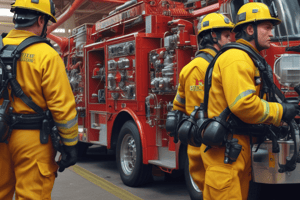Podcast
Questions and Answers
Which tank holds the largest capacity among the listed tankers?
Which tank holds the largest capacity among the listed tankers?
- South end total
- E-111
- T-110
- T-78 (correct)
What is the minimum intake pressure required for the first engine at the hydrant?
What is the minimum intake pressure required for the first engine at the hydrant?
- 25 psi
- 10 psi
- 20 psi (correct)
- 15 psi
What is the maximum pumping pressure each engine must maintain to avoid activating the intake pressure relief valve?
What is the maximum pumping pressure each engine must maintain to avoid activating the intake pressure relief valve?
- 90 psi
- 80 psi
- 70 psi
- 100 psi (correct)
When laying supply line, what speed should be maintained?
When laying supply line, what speed should be maintained?
What happens when the first arriving engine lays LDH supply line?
What happens when the first arriving engine lays LDH supply line?
Flashcards are hidden until you start studying
Study Notes
Water Supply Operations
- Tankers used for water supply:
- E-111 Tanker: 2,000 gallons
- T-110 Tanker: 2,500 gallons
- T-78 Tanker: 6,000 gallons
- South end total capacity: 10,050 gallons
Relay Pumping
- Primary method: Reverse lay, unless circumstances dictate otherwise
- All engines and pumping tankers carry a total of 1,100 ft of LDH (Large Diameter Hose)
- Last 100 ft of LDH is RED
- Apparatus speed when laying supply lines: 5 to 10 mph
- Space for incoming apparatus should be considered to ensure access
- For every 1,100 ft of LDH laid, an engine is needed to relay/tandem pump the lines
- Forward lays greater than 1,100 ft require an engine at the hydrant to pump the LDH lines
- Engine at the hydrant needs to maintain a minimum intake pressure of 20 psi
- Each engine pumping through discharge needs to maintain a maximum pumping pressure of 80 psi to 100 psi
- This prevents the "intake pressure relief valve" of the receiving engine from activating
Nurse Ops (Preferred method when hydrants are unavailable)
- First arriving engine:
- Straight lays LDH supply line with manifold at the end
- Location chosen must be accessible for tankers
- Arriving tankers:
- Connect a minimum of two 50 ft sections of 3" supply line
- A third section may be added if needed
- This minimizes delays in receiving water while other tankers disconnect
- Receiving engine:
- Advises over radio or with 3 horn blasts to have water sent
- Water supply is only established once the tankers have sent water
Studying That Suits You
Use AI to generate personalized quizzes and flashcards to suit your learning preferences.




